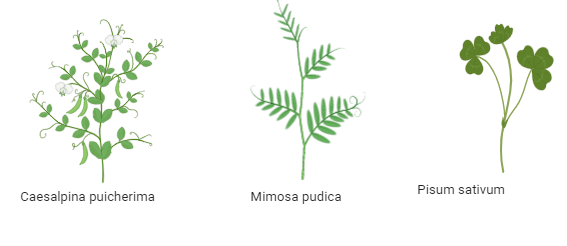
These are three examples of family Fabaceae. Answer the following.
Tendrils of Pisum are the modification of

A. Terminal leaflets
B. Axial leaflet
C. Leaflet
D. None of the above

Answer
480k+ views
Hint: A modified stem or leaf is known as a tendril. In certain plants, it is contained. It performs functions such as assistance, attachments, invasion, and occasionally. In plants such as grapevines and pumpkins, for example, stem tendrils extend for climbing from axillary buds. Slender rounded and spirally coiled structures are these. They do not have a lamina or a razor, however, photosynthesis is carried out.
Complete answer: In pea plants, tendril growth is caused by rapid cell divisions in tendril cells that are away from support. A tendril is a slender stem- or petiole-like structure used to loop around or hook support by vines and lianas (climbing plants). In plants with weak stems, leaves or a part of leaves are modified into green thread-like tendril-like structures that help climb around the support. Upper leaflets, modified into tendrils, in pea plants (Pisum sativum). The young leaves, roots, vines, and flowers of a pea plant are pea tendrils, otherwise known as pea shoots. All the plant parts are edible. Usually, the type of pea plant is either a snow pea or a shelling pea, and the original variety would have an effect on the tendrils. Modified terminal leaflets are the tendrils of Pisum. The pea plant is a climber and climbs are referred to as tendrils produced with the aid of the modified terminal leaflets at the apex of compound leaves and also form branched tendrils. The modified branches that emerge as buds in the leaf axil are axial leaflets. A leaflet is a part of the leaf that is separate but distinct.
Thus, choice A is the correct one.
Note: A tendril is a threadlike type of a modified stem, leaf, or petiole. Its use in climbing plants is to give parasitic plants support, attachment, and cellular invasion, typically by twining around appropriate hosts discovered by contact.
Complete answer: In pea plants, tendril growth is caused by rapid cell divisions in tendril cells that are away from support. A tendril is a slender stem- or petiole-like structure used to loop around or hook support by vines and lianas (climbing plants). In plants with weak stems, leaves or a part of leaves are modified into green thread-like tendril-like structures that help climb around the support. Upper leaflets, modified into tendrils, in pea plants (Pisum sativum). The young leaves, roots, vines, and flowers of a pea plant are pea tendrils, otherwise known as pea shoots. All the plant parts are edible. Usually, the type of pea plant is either a snow pea or a shelling pea, and the original variety would have an effect on the tendrils. Modified terminal leaflets are the tendrils of Pisum. The pea plant is a climber and climbs are referred to as tendrils produced with the aid of the modified terminal leaflets at the apex of compound leaves and also form branched tendrils. The modified branches that emerge as buds in the leaf axil are axial leaflets. A leaflet is a part of the leaf that is separate but distinct.
Thus, choice A is the correct one.
Note: A tendril is a threadlike type of a modified stem, leaf, or petiole. Its use in climbing plants is to give parasitic plants support, attachment, and cellular invasion, typically by twining around appropriate hosts discovered by contact.
Latest Vedantu courses for you
Grade 10 | MAHARASHTRABOARD | SCHOOL | English
Vedantu 10 Maharashtra Pro Lite (2025-26)
School Full course for MAHARASHTRABOARD students
₹33,300 per year
Recently Updated Pages
Master Class 9 General Knowledge: Engaging Questions & Answers for Success

Master Class 9 English: Engaging Questions & Answers for Success

Master Class 9 Science: Engaging Questions & Answers for Success

Master Class 9 Social Science: Engaging Questions & Answers for Success

Master Class 9 Maths: Engaging Questions & Answers for Success

Class 9 Question and Answer - Your Ultimate Solutions Guide

Trending doubts
What are Quantum numbers Explain the quantum number class 11 chemistry CBSE

Who built the Grand Trunk Road AChandragupta Maurya class 11 social science CBSE

1 Quintal is equal to a 110 kg b 10 kg c 100kg d 1000 class 11 physics CBSE

The reason why India adopted the policy of nonalignment class 11 social science CBSE

The plastids which are coloured green and colourless class 11 biology CBSE

Earth rotates in which direction A East to west B West class 11 physics CBSE




